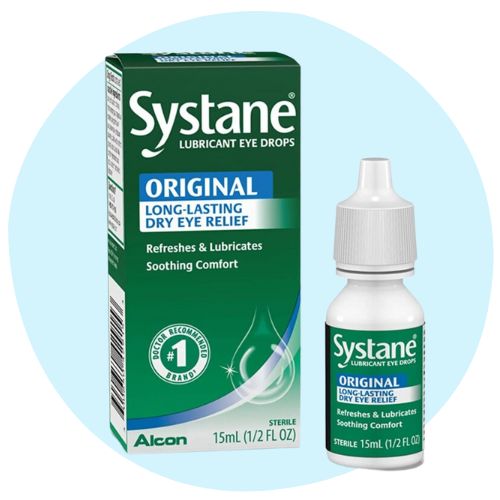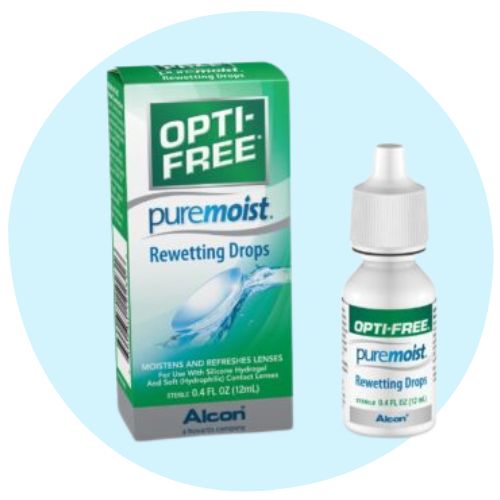Updated on January 30, 2025
The Best Eye Drops for Contacts


Vision Center is funded by our readers. We may earn commissions if you purchase something via one of our links.
Eye drops are a common treatment for the irritation and discomfort associated with dry eye. There are many types of eye drops, also known as artificial tears. However, not all of them can be used with contacts.
According to Dr. James Kelly of Kelly Vision Center, "In my many years as an ophthalmologist, I have found that patients will experiment with several types of drops until they find one that suits them. There is a bit of trial and error in the process (of choosing eye drops)."
We've compiled a list of the 6 best eye drops for contact lens wearers in 2024. You can buy all of these on Amazon using the links provided.
Everything We Recommend
6 Best Eye Drops for Contacts 2024
Systane Long Lasting Lubricant Eye Drops

Systane Lubricant Eye Drops provide temporary relief for dry eye symptoms. The lubricating eye drops have been clinically proven to lessen the signs and symptoms of dry eye quickly.
Features:
- Reduces the signs and symptoms of dry eye
- Provides long-lasting relief and soothing contact lens comfort
- Single-use convenience
Refresh Contacts, Eye Drops For Dry Eyes

The moisture-rich formula of the Refresh Contacts Eye Drops soothes and relieves dryness resulting from contact lens wear.
These eye drops are available in a convenient multi-dose bottle. They're safe to use with contacts as necessary. Wearers can keep their contacts in upon application.
Features:
- Original strength formula
- Relieves mild signs and symptoms of eye dryness resulting from contact lens wear
- Offers quick relief by instantly moisturizing the eyes
- Recommended for use with silicone acrylate and fluorosilicone acrylate rigid gas permeable (RGP) lenses
Opti-Free Puremoist Rewetting Drops

Opti-Free Puremoist Rewetting Drops provide moisture and comfort to the eyes for all-day use. The drops moisten, lessen discomfort, and help remove materials that may lead to eye irritation. The safe and effective solution can be used on silicone hydrogel and soft lenses while remaining in the eye.
The eye drops prevent protein deposits and build-ups that tend to develop with the consistent use of contact lenses. The formula is thimerosal and sorbic acid-free.
Features:
- Keeps eyes moist when wearing contacts
- Removes particles that lead to irritation
- Helps prevent deposit build-up
- Recommended for use with all silicone hydrogel and other soft contact lenses
blink-n-clean Lens Drops

The Blink-N-Clean Lens Drops help refresh dry eyes and lessen eye irritation while wearing contact lenses. The formula reduces protein buildup, allowing you to wear your contact lenses for longer periods.
These eye drops come in an easy-to-use bottle that’s convenient to carry around.
Features:
- Moisturizes and removes protein build-up from the eyes
- Designed for soft and RGP contact lenses
- Suitable for daily use
Boston Rewetting Drops for Rigid Gas Permeable Contacts

The Bausch + Lomb Boston Rewetting Drops relieve mild irritation and discomfort while wearing RGP contact lenses. The solution helps remove debris that may result in irritation, discomfort, and blurred vision.
Using these eye drops may extend contact lens wearing time by wetting the lenses while they are in your eyes.
Features:
- Moisturizes the eyes and relieves discomfort during contact lens wear
- Removes debris from the eyes
- Suitable for use with RGP lenses
Refresh Relieva for Contacts Lubricant Eye Drops For Dry Eyes

Refresh Relieva Eye Drops provide quick relief from the discomfort of dry and irritated eyes. It also prevents further irritation.
The formula features hydrocell technology, which delivers hydration and maintains the cells' volume on the ocular surface. Wearers can keep their contact lenses in upon application.
Features:
- Recommended for use with silicone acrylate and fluorosilicone acrylate RGP lenses
- Also suitable for rewetting soft contacts and other types of RGP lenses
- Safe to apply drops while contacts are in the eyes
Where to Buy Glasses + Contacts
Best Overall: Warby Parker
Fastest Delivery: EyeBuyDirect
Also Great: Liingo
Best Place to Buy Contacts: Discount Contacts
What Is Dry Eye Syndrome?
Dry eye occurs when your eyes do not produce enough tears or when your tear film does not work correctly. This can make your eyes feel uncomfortable. In some circumstances, it can lead to vision problems.
Why Do Contacts Give You Dry Eye?
Wearing contact lenses for extended periods can cause dry eyes. Approximately half of contact lens wearers experience contact lens-related dry eye.
High-water content lenses are more likely to result in dry eyes than those with low water content. They usually send moisture to the eye when you first fit them in but can dry out quicker.
Eye drops for contacts are a cheap and easy option to improve contact lens comfort. However, you may need to try lenses with various water contents until you discover one that works for you.
How to Prevent Contacts From Drying Out
There are several ways to relieve dry eyes:
- Switching to a different type of contact lens
- Caring for your contact lenses by keeping them clean and changing them as recommended
- Only wearing your lenses for the amount of time your eye doctor prescribes
- Moistening your eyes with rewetting drops before inserting your contact lenses
- Using eye drops throughout the day to lubricate contact lenses
Rewetting eye drops are an easy way to provide relief for dry eyes when you wear contacts. These are different than regular eye drops (artificial tears), or eye drops for itch relief. They are only to be used by people who are wearing contacts.
How to Choose the Right Type of Eye Drops
If you're experiencing dry eye from your contacts, speak with your eye doctor. They may recommend eye drops or a different contact lens brand. Their professional medical advice is the best way to find the right contact lens for you.
Things to consider when choosing eye drops for contacts include:
Ingredients
Contact lens wearers must check the ingredients label on a box of eye drops before using them. Avoid formulas that contain preservatives, such as benzalkonium chloride, which can damage your eye with extended use. Instead, seek a preservative-free formula designed specifically for contact lenses.
Usability
The type of eye drops you're most likely to use is the type that's easiest to reach for. Consider the size and shape of the bottle of eye drops to determine its ease of use. Eye drop bottles are usually small enough to fit in your pocket, so you can use them as needed.
Type of Contacts
The two main categories of contact lenses include:
Soft Contact Lenses
Soft contact lenses consist of soft, flexible plastics. They allow oxygen to flow through to the cornea. These lenses are easier to adjust and more comfortable than RGP lenses. Newer soft lens materials include silicone hydrogels to deliver more oxygen to your eyes.
View the best contacts for dry eyes.
Rigid Gas Permeable (RGP) Contact Lenses
Rigid gas permeable contact lenses (RGPs) are more durable than soft contact lenses. They’re also more resistant to deposit buildup and offer clear, crisper vision.
RGPs are usually less expensive because one pair can last a year or more. With soft contacts, you have to purchase a regular supply to last the whole year. They’re also easier to handle and are less likely to rip or tear.
However, RGPs are not as comfortable initially compared to soft contacts. It may take a few weeks to adjust to wearing RGPs compared to a few days for soft contacts.
To avoid contact lens irritation, always practice healthy eye care habits. Remember that all types of contact lenses are medical devices that a doctor must prescribe. This includes cosmetic lenses that do not correct the vision but change the color or look of the eye.
Summary
Eye drops help reduce dryness when wearing contact lenses. In this article, we've outlined some of the best eye drops for contact lens wearers. If you experience irritation or other problems when using a product, consult your eye doctor.
In this article
9 sources cited
Updated on January 30, 2025
Updated on January 30, 2025
About Our Contributors
Lauren, with a bachelor's degree in biopsychology from The College of New Jersey and public health coursework from Princeton University, is an experienced medical writer passionate about eye health. Her writing is characterized by clarity and engagement, aiming to make complex medical topics accessible to all. When not writing, Lauren dedicates her time to running a small farm with her husband and their four dogs.
Dr. Melody Huang is an optometrist and freelance health writer with a passion for educating people about eye health. With her unique blend of clinical expertise and writing skills, Dr. Huang seeks to guide individuals towards healthier and happier lives. Her interests extend to Eastern medicine and integrative healthcare approaches. Outside of work, she enjoys exploring new skincare products, experimenting with food recipes, and spending time with her adopted cats.








